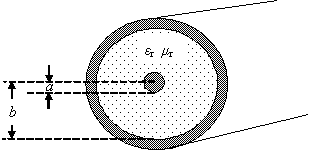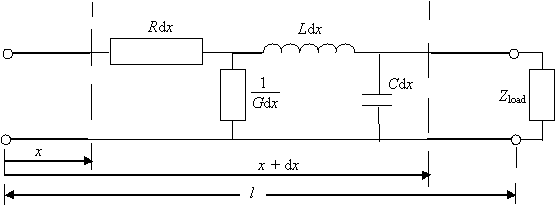|
Instance title
|
public void setTitle(String title)
|
|
public String getTitle()
|
|
Frequency, f
|
public void setFrequency(double frequency)
|
|
public double getFrequency()
|
|
public double getRadialFrequency()
|
|
Load impedance, Zload
|
public void setLoadImpedance(double impedance)
|
public void setLoadImpedance(Complex impedance)
|
|
public Complex getLoadImpedance()
|
|
Line length, l
|
public void setLineLength(double length)
|
|
public double getLineLength()
|
|
Distributed resistance, R
|
public void setDistributedResistance(double resistance)
|
|
public double getDistributedResistance()
|
|
Distributed conductance, G
|
public void setDistributedConductance(double conductance)
|
|
public double getDistributedConductance()
|
|
Distributed inductance, L
|
public double getDistributedInductance()
|
|
Distributed capacitance, C
|
public double getDistributedCapacitance()
|
|
Distributed impedance, R + jωL
|
public Complex getDistributedImpedance()
|
|
Distributed admittance, G + jωC
|
public Complex getDistributedAdmittance()
|
|
Characteristic impedance, Zo
|
public Complex getCharacteristicImpedance()
|
|
public Complex getIdealCharacteristicImpedance()
|
|
public double getIdealCharacteristicImpedanceAsReal()
|
|
public Complex getLowLossCharacteristicImpedance()
|
|
Input impedance, Zi
|
public Complex getInputImpedance()
|
|
public Complex getIdealInputImpedance()
|
|
public Complex getLowLossInputImpedance()
|
|
Shorted line impedance, Zload = 0
|
public Complex getShortedLineImpedance()
|
|
public Complex getIdealShortedLineImpedance()
|
|
public Complex getLowLossShortedLineImpedance()
|
|
Open line impedance, Zload = ∞
|
public Complex getOpenLineImpedance()
|
|
public Complex getIdealOpenLineImpedance()
|
|
public Complex getLowLossOpenLineImpedance()
|
|
Line signal wavelength, λ
|
public double getWavelength()
|
|
public double getIdealWavelength()
|
|
public double getLowLossWavelength()
|
|
Quarter-wave line impedance
|
public Complex getQuarterWaveLineImpedance()
|
|
public Complex getIdealQuarterWaveLineImpedance()
|
|
public Complex getLowLossQuarterWaveLineImpedance()
|
|
Half-wave line impedance
|
public Complex getHalfWaveLineImpedance()
|
|
public Complex getIdealHalfWaveLineImpedance()
|
|
public Complex getLowLossHalfWaveLineImpedance()
|
|
Reflection coefficient
|
public Complex getReflectionCoefficient()
|
|
public Complex getIdealReflectionCoefficient()
|
|
public Complex getLowLossReflectionCoefficient()
|
|
Standing-wave ratio
|
public double getStandingWaveRatio()
|
|
public double getIdealStandingWaveRatio()
|
|
public double getLowLossStandingWaveRatio()
|
|
Attenuation constant, α
|
public double getAttenuationConstant()
|
|
public double getIdealAttenuationConstant()
|
|
public double getLowLossAttenuationConstant()
|
|
Phase constant, β
|
public double getPhaseConstant()
|
|
public double getIdealPhaseConstant()
|
|
public double getLowLossPhaseConstant()
|
|
Propagation constant, γ = α + jβ
|
public Complex getPropagationConstant()
|
|
public Complex getIdealPropagationConstant()
|
|
public Complex getLowLossPropagationConstant()
|
|
Phase velocity, vp
|
public double getPhaseVelocity()
|
|
public double getIdealPhaseVelocity()
|
|
public double getLowLossPhaseVelocity()
|
|
Group velocity, vg
|
public double getGroupVelocity()
|
|
public void setDelta(double delta)
|
|
public double getGroupPhaseVelocity()
|
|
public double getLowLossGroupVelocity()
|
Transmission matrix
(ABCD matrix)
|
public ComplexMatrix getABCDmatrix()
|
|
public ComplexMatrix getIdealABCDmatrix()
|
|
public ComplexMatrix getLowLossABCDmatrix()
|
|
Segment length
|
public void setSegmentLength(double segLength)
|
|
Segment output voltage
|
public void setOutputVoltage(Phasor voltage)
|
|
public void setOutputVoltage(Complex voltage)
|
|
public void setOutputVoltage(double magnitude, double phase)
|
|
Segment output current
|
public void setOutputCurrent(Phasor current)
|
|
public void setOutputCurrent(Complex current)
|
|
public void setOutputCurrent(double magnitude, double phase)
|
|
Segment input voltage and current
|
public Phasor[] getInputVandIasPhasor()
|
|
public Phasor[] getInputVandIasPhasor(double segmentLength)
|
|
public Complex[] getInputVandIasComplex()
|
|
public Complex[] getInputVandIasComplex(double segmentLength)
|
|
public double[] getInputVandIasReal()
|
|
public double[] getInputVandIasReal(double segmentLength)
|
|
public double[] getInputVandIasMagnitudeAndPhase()
|
|
public double[] getInputVandIasMagnitudeAndPhase(double segmentLength)
|
|
Segment input voltage
|
public Phasor getInputVoltageAsPhasor()
|
|
public Complex getInputVoltageAsComplex()
|
|
public double getInputVoltageAsReal()
|
|
public double[] getInputVoltageAsMagnitudeAndPhase()
|
|
Segment input current
|
public Phasor getInputCurrentAsPhasor()
|
|
public Complex getInputCurrentAsComplex()
|
|
public double getInputCurrentAsReal()
|
|
public double[] getInputCurrentAsMagnitudeAndPhase()
|
|
Deep Copy
|
public CoaxialLine copy()
|
public Object clone()
|


















































